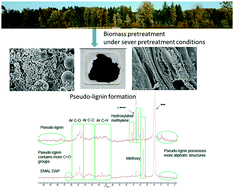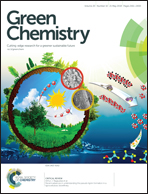Recent advances in understanding the pseudo-lignin formation in a lignocellulosic biorefinery
Abstract
The formation of lignin-like structures by the degradation primarily of plant polysaccharides has been observed after the severe thermochemical acidic pretreatment of lignocellulosic biomass. These structures were found to be deposited as droplets and microspheres on the surface of solid biomass residue and/or in liquid effluent. These structures showed lignin-like properties and yielded a positive Klason lignin (K-lignin) value, and are termed pseudo-lignins and/or humins. Pseudo-lignin is an aromatic material containing hydroxyl and carbonyl functional groups, which contributes to K-lignin values but is not derived thereof. Pseudo-lignin arises from the polymerization/condensation reactions from key intermediates such as 3,8-dihydroxy-2-methylchromone and 1,2,4-benzenetriol derived from furfural (FF) and 5-hydroxymethylfurfural (5-HMF), respectively. Furthermore, pseudo-lignin retards the biological conversion of pretreated biomass through unproductive binding to enzymes/microbes and a physical hindrance to enzymes and microbes by blocking the active cellulose surface binding sites. This necessitates a fundamental understanding of the pseudo-lignin structure and its effect on biomass recalcitrance. This review examines the pseudo-lignin formation during acidic and hydrothermal biomass pretreatments and the cooling process after pretreatment, which are applied to biomass for biofuel synthesis through a biochemical route. The review article is divided into five parts: the first part gives the background information on pseudo-lignin formation during different pretreatment processes for the conversion of biomass to biofuels, the second part focuses on the chemistry and mechanism of pseudo-lignin formation, the third part emphases on the different analytical techniques used for pseudo-lignin characterization and recalcitrance elucidation, the fourth part illustrates the recalcitrance behaviour of pseudo-lignin, and the fifth part deals with the practical consideration regarding the design of the processes for the prevention of pseudo-lignin formation.



 Please wait while we load your content...
Please wait while we load your content...